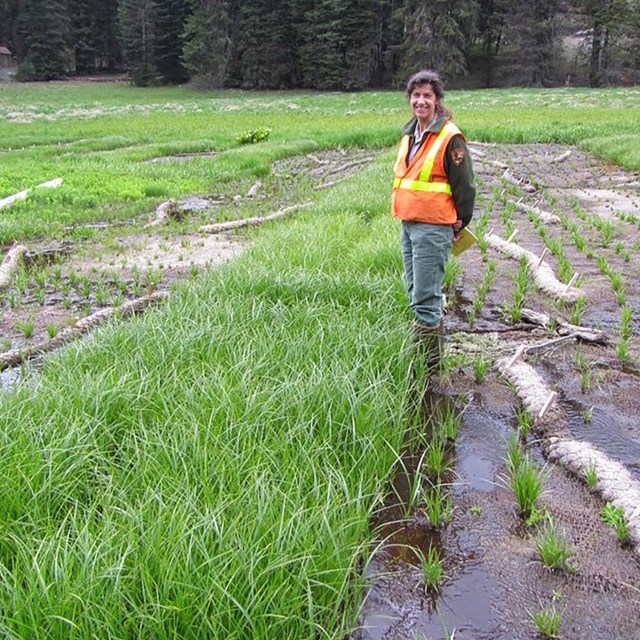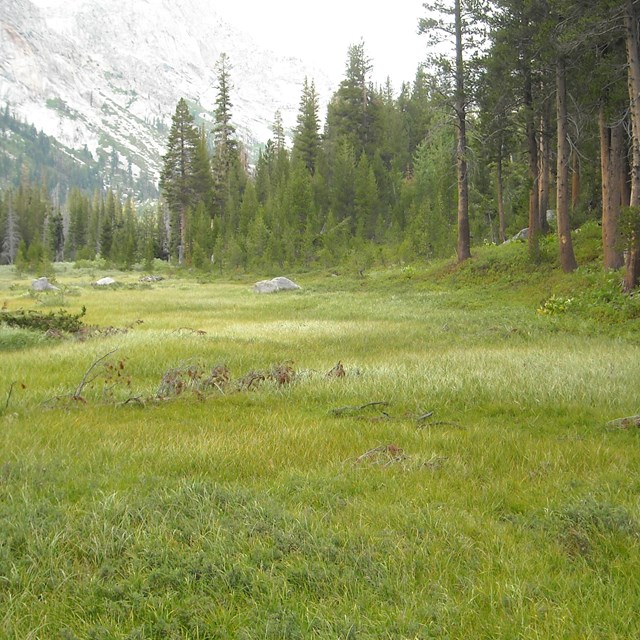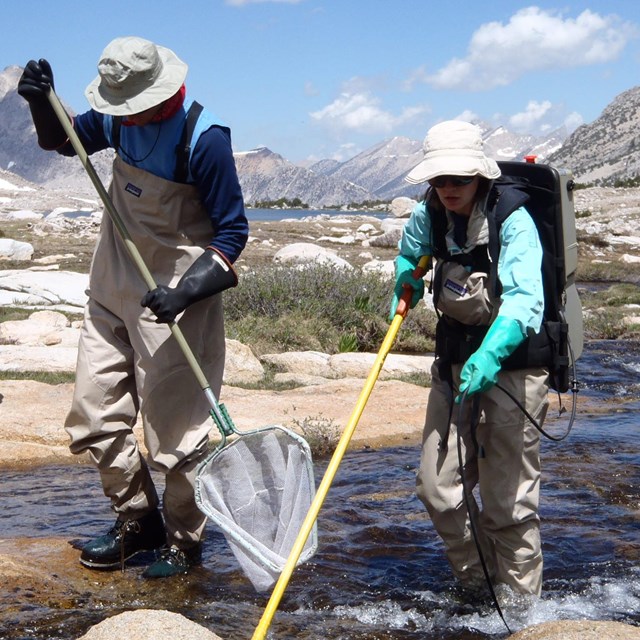
Visitors to Log Meadow in Giant Forest during recent summers (2021-2023) may have noticed young adults wearing hardhats or sunhats, high rubber boots and field clothes in the upper portion of the meadow, working hard to restore historic water flow patterns. They used hand tools, hand-made hay bales, sticks and logs, and channel widening to slow water flow and spread it over a larger area, beginning to re-water areas of the meadow dried out by historic grazing impacts. 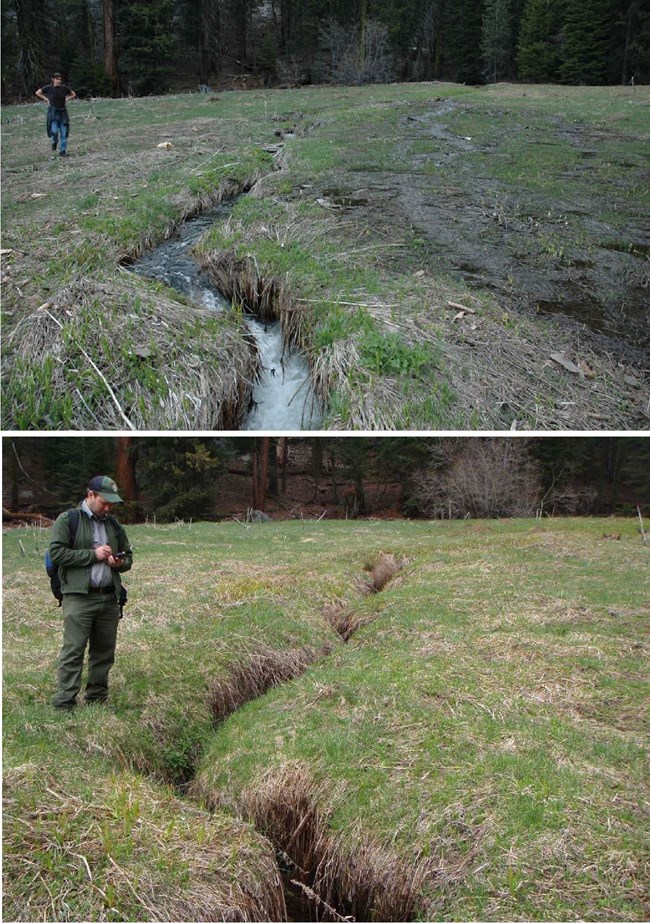
National Park Service Why is restoration needed?Starting in 1861, historic ranching operations brought cattle to graze in Log Meadow. Degraded from the cattle’s munching and trampling, the usually thick mat of meadow vegetation gave way to spring flood waters, which led to erosion gullies at the head of Log Meadow. Over the decades, the gullies ran longer and deeper. Although the meadow is no longer grazed, three ditches and gullies remain, confining and channeling surface flow that should disperse across the meadow as sheet flow. These ditches and channels removed water from portions of the wetland, drying the soils. In areas de-watered by channelization of water, wetland plants cannot thrive, and plants adapted to upland, drier conditions can establish and expand. This project is filling the main erosion gully shown in the photos to the right so that water can spread across the surface of the meadow, re-wetting meadow soils. Meadows are ecological hotspots.Wet soils of meadows support a diversity of plants with high productivity. Although they occupy a fraction of the total land area in the Sierra Nevada, they are biological hotspots. In addition, meadows are critical for cleaning and storing water, storing carbon, and providing recreational opportunities. Many a visitor has savored mixed colors of flowers in bloom, watched birds feed on insects, or chuckled at the antics of a bear cub while at the meadow edge. Because of the erosion gullies in Log Meadow, these values have been in jeopardy. Healthy meadows are more resilient.Healthy meadows are more resilient to threats. Climate change affects meadows by modifying the timing, duration, and amount of precipitation and snowpack in the Sierra Nevada. Healthy meadows provide climate change resiliency by increasing groundwater storage, improving water quality, reducing peak flood flows, and providing critical habitat. 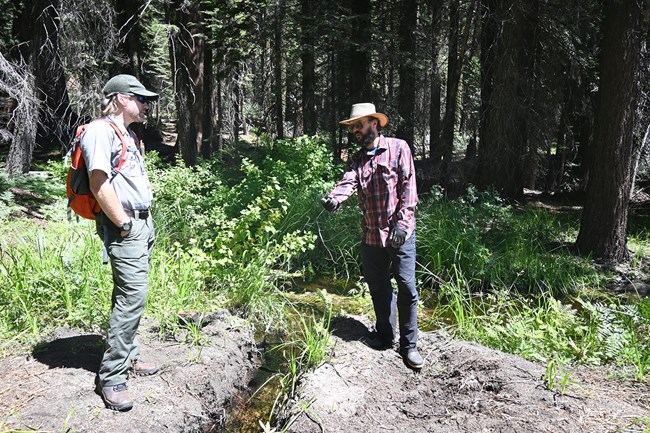
An Opportunity to Pilot Wilderness-compatible TechniquesThis project has benefits beyond its restoration of one meadow. Another goal is piloting light-handed techniques and using hand labor, exploring the potential to expand restoration efforts to wilderness meadows. Many remote meadows were grazed by sheep or cattle in the century prior to designation under the Wilderness Act of 1964. Some of these wilderness meadows are degraded as much as more accessible meadows outside of wilderness. Most meadow restoration projects in the Sierra Nevada have used techniques that require motorized vehicles and large machinery to move soil and rock. One successful meadow restoration was Halstead Meadow along the Generals Highway, north of Log Meadow. In that project, tons of earth were used to pack a deep erostion gully using heavy machinery. (Learn more on our Healing a Mountain Meadow web page.) While the scale of the Halstead Meadow restoration required heavy machinery, some wilderness meadows could be restored using the hand techniques piloted in this restoraton without impacting visitors' wilderness experience. In this project, park staff and partners are developing and testing hand-labor restoration techniques so that meadow function can be improved across more of the Sierra Nevada’s higher elevation meadows. What methods are we using?Making and Using Hay: During the summers of 2022 and 2023, Evan taught crews associated with American Conservation Experience (ACE), California Conservation Corps (CCC), and Walker Basin Conservancy to cut hay from meadow plants using scythes, rake the hay by hand, and pack it into human-operated hay balers. Then "haydobe", a wetland restoration version of adobe, can be made by mixing mud from the meadow with handfuls of meadow hay. Haydobe is used to fill the erosion gully. 


Next StepsIn Spring 2024, the site will be evaluated to see if the modified channel survived the winter and if the desired result of water flowing more evenly over the meadow surface was achieved. If so, the next step will be re-planting meadow plants that should have sufficient water to support them as a result of the restored water flow pattern. These plants will come from the park's nursery where native plants are raised for restoration of disturbed sites.What we learn from this project informs how and where we continue the important work of restoring more remote meadows damaged by historic livestock grazing practices. 
Wetland importance and restoration
|
Last updated: April 22, 2024

